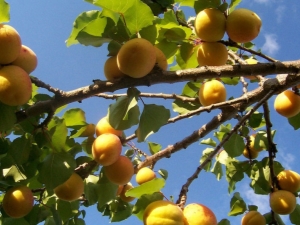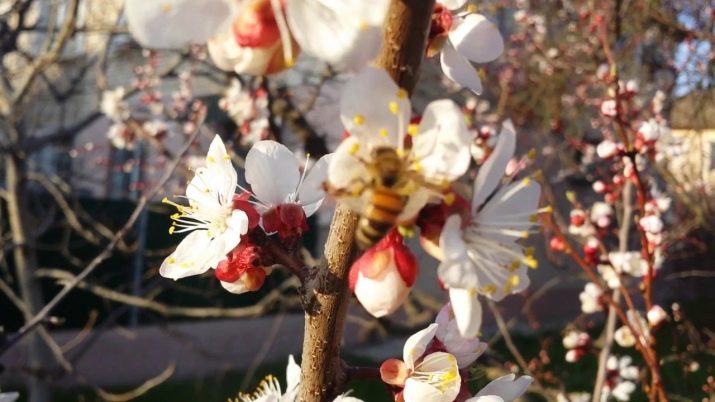How are apricots pollinated?

Growing apricots is not very troublesome, however, requiring compliance with certain agricultural practices. Special mention deserves such a nuance as the pollination of a fruit tree.What is this process, how is it performed, in what cases is manual pollination used? All this will tell our article.
Special features
It is difficult to imagine fruit ripening in crops such as cherry, pear or apricot without the work of pollinators. The fruit formation process itself in most trees depends on the need to exchange pollen, and this can be achieved through the whiffs of wind or human activity. Yet insects play the main role here.
Each insect visiting a plant is considered a pollinator. Indeed, for pollination, contact with pollen, which is attached to the body of an insect, and then transferred to the flower of another plant is considered sufficient. There are separate groups of insects that are very important for pollination. The most common insects in temperate latitudes are beetles, butterflies, wasps, bumblebees, hornets, bees.
Installing hives near a garden will not solve problems, since pollination is a complex process and is influenced by many different factors. In order for the insects to fly up to the inflorescence and produce their work, normal weather conditions are necessary, the location of the garden itself is also taken into account.
In extreme heat or extreme cold, insects do not fly to the pollination. Temperatures below 12 ° C and above 35 ° C are critical for bees.
Weather conditions strongly influence the duration of the whole flowering, of course, this affects the quality of the fertilization of trees accordingly. On cooler days, when it rains, trees can bloom for a period of up to 10 days, and sometimes more, insects in such weather visit inflorescences too bad. Pollen begins to germinate more slowly, so there are more unfertilized flowers.
At the same time, the appearance of the sun for only one or half a day is sufficient time for insects to fertilize all the inflorescences.
Today, there are two types of pollination: cross and self-pollination. Trees, in turn, can be self-fruitless and self-bearing. The self-fertile type of trees forms the ovaries of the inflorescences after pollination by their own pollen. But for the self-infested, pollination from completely different varieties will be needed.
Most of the varieties of all fruit trees belong to the self-infertile types, so it’s quite difficult to decide right away whether a pollinator is needed or not. Such garden plantings, unfortunately, may bring too little crop, and may not bear fruit at all. Most of the apricot varieties are self-fertile; they can be pollinated on their own. You can also meet hybrid forms or self-infertile.
Artificial or natural method?
Natural type of pollination occurs most often. This is the pollinating process that insects produce, or one that is carried out due to some other natural phenomena. During the artificial dusting process, pollen is transferred from one flower to another, thus increasing the yield, and if necessary, this method can be used to develop a new variety, more promising.
Apricots are a self-pollinating type of fruit tree. However, due to flowering, starting too early, insects may be absent, for this reason manual pollination is produced. This process is also necessary for trees if unfavorable weather falls during the flowering period.
Manual pollination significantly increases the level of yield, especially when using pollen from trees of various varieties. Fruits produced during ripening will be much better. They will be larger in shape, and the taste is much better. Breeders have shown that manual pollination helps to end up with more crop than after the natural process. Yields increase by about 40%.
Procedure
For pollination of apricot blossoms, you can use ordinary cotton wool or take, for example, rabbit fur.Then you need a piece of the selected material slightly attached to each flower. You can also take an ordinary brush for brushing your teeth, preferably an electric one. It is brought close to the inflorescences and lasts 10 seconds.
If an average fan or hair dryer is turned on at the middle level, then the resulting air flow is also able to pollinate apricot inflorescences. Such a weak air flow should be directed to the flowers of the tree and alternately walk through each inflorescence. By the way, after such procedures, fruits of unusual shape are sometimes obtained - flattened or slightly elongated.
To make the process as efficient as possible, pollination should be carried out 3 times (at the beginning, in the middle and after completion of flowering). It is best to do this work in the morning (before 11 o'clock) or in the evening.
Pollinating trees
In order to effectively increase the yield during the cultivation of the self-fruit trees, pollinating varieties are planted next to them. How to choose a suitable pollinator? You just need to follow further instructions:
- A planted pollinator tree must necessarily correspond to the varieties of apricots growing in the garden: firstly, the terms of fruiting, secondly, the timing of flowering;
- a pollinator variety should belong to categories of standard or prospective assortments that are suitable for cultivation on certain soils in a given climate;
- apricot pollinator variety must have good pollination;
- in addition, it is necessary to take into account the taste and quality of the harvest from the varieties that are used in the joint planting.
The following video demonstrates flowering and pollination of apricot.


























